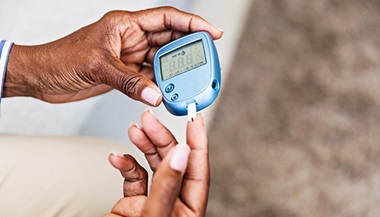Diabetic Neuropathy
What is diabetic neuropathy?
Neuropathy is a complication of diabetes that can lead to problems throughout the body. Diabetes can affect nerves that control movement, sensation and other functions.
If you have diabetes, you can develop nerve problems at any time. Sometimes, neuropathy can be the first sign of diabetes. Significant nerve problems (clinical neuropathy) can develop within the first 10 years after a diabetes diagnosis. The risk of developing neuropathy increases the longer you have diabetes. About half of people with diabetes have some form of neuropathy.
What causes diabetic neuropathy?
Although the exact causes of diabetic neuropathy are unknown, several factors may contribute to the disorder, including:
- High blood sugar (glucose). High blood glucose causes chemical changes in nerves and impairs the nerves’ ability to transmit signals. It can also damage blood vessels that carry oxygen and nutrients to the nerves.
- Metabolic factors. In addition to glucose levels, high triglyceride and cholesterol levels are also associated with increased risk of neuropathy. Patients who are overweight or obese are also at increased risk of developing neuropathy.
- Inherited factors. There are some genetic traits that may make some people more susceptible to nerve disease than others.
What are the symptoms and types of diabetic neuropathy?
The symptoms of diabetic neuropathy depend on the type of neuropathy and on which and how many nerves are affected.
Focal Neuropathy (Diabetic Mononeuropathy)
This type of diabetic neuropathy affects one nerve at a time, and the symptoms depend on which nerve is affected. For example, it can affect nerves in the chest (thoracic nerves) and cause numbness and pain in the chest wall that mimics angina, heart attack or appendicitis.
Other types of focal neuropathy can cause:
- Pain in the thighs.
- Severe pain in lower back or pelvis.
- Pain in the chest, stomach or flank.
- Aching behind the eyes.
- Inability to focus the eyes.
- Double vision.
- Paralysis on one side of the face.
- Hearing problems.
Diabetic Polyneuropathy
Diabetic polyneuropathy (DPN) affects multiple peripheral sensory and motor nerves that branch out from the spinal cord into the arms, hands, legs and feet. Typically, the longest nerves — those that extend from the spine to the feet — are affected the most.
DPN can cause:
- Unusual sensations (paresthesias) such as tingling, burning or prickling.
- Numbness and pain in the hands, legs and feet.
- Weakness of the muscles in the feet and hands.
- Sharp pains or cramps.
- Extreme sensitivity to touch.
- Insensitivity to pain or temperature changes.
- Loss of balance or coordination, and difficulty walking on uneven surfaces.
Because it inhibits the ability to sense problems, DPN can put a person at risk for injuries of the feet and toes, and lead to the development of ulcers, wounds and chronic infections in the feet.
Some mild cases of DPN may go unnoticed for years, but worsening nerve damage can cause severe pain and make the simplest of daily activities — such as sleeping or walking — extremely uncomfortable.
If left untreated, DPN can result in further nerve damage to other parts of the body, such as the eyes, digestive tract and sexual organs. It also is the primary cause of amputations, resulting in nearly one case every five-and-a-half minutes in the United States.
DPN has two distinct types: diabetic autonomic neuropathy and proximal neuropathy.
Diabetic Autonomic Neuropathy
Diabetic autonomic neuropathy primarily affects the autonomic nerves that serve internal organs, processes, and systems of the heart, digestive system, sexual organs, urinary tract and sweat glands.
This kind of diabetic polyneuropathy can cause symptoms such as:
- Persistent nausea and vomiting.
- Diarrhea, constipation.
- Sweating abnormalities.
- Sexual dysfunction.
- Digestive problems.
- Low blood pressure.
- Impaired perception of pain.
- Hypoglycemia.
Proximal Neuropathy (Diabetic Amyotrophy)
Proximal neuropathy is known by many names, and is a relatively rare type of diabetic neuropathy that occurs in about 1% of patients with type 2 diabetes. It tends to affect older adults, and can strike those with recently diagnosed or well-controlled diabetes.
The main symptom is nerve pain that starts in the upper thigh of one leg and can involve the hip and lower back. Weight loss is a symptom in about 35% of patients with proximal neuropathy, and about 18% experience weakness in the affected area in addition to the pain. Rarely, proximal neuropathy can occur in the arm.
As the condition progresses over months, the pain can spread to involve the upper and lower parts of both legs. After several months, symptoms tend to ease up, but patients can be left with lasting disability, including foot drop and recurrence of symptoms.
The symptoms of diabetic neuropathy may resemble other conditions or medical problems. Always consult your doctor for a diagnosis.
How is diabetic neuropathy diagnosed?
Early diagnosis of diabetic neuropathy gives patients the best chance of effective treatment. But since not all foot or limb pain means diabetic neuropathy, accurate diagnosis is important to ensure appropriate treatment.
Diagnosis of diabetic neuropathies is based on history, clinical examination and supporting laboratory tests. Your doctor may:
- Check muscle strength and reflexes.
- Check muscle sensitivity to position, vibration, temperature and light touch.
- Request additional tests, such as:
- Ultrasound to determine how parts of the urinary tract are functioning.
- Electromyography to determine how muscles respond to electrical impulses.
- Nerve conduction studies to check flow of electrical current through a nerve.
- Skin biopsies to evaluate cutaneous nerve innervation.
- Nerve and muscle biopsies for histopathological evaluation.
A comprehensive evaluation — including a review of blood pressure, cholesterol and blood glucose screenings — combined with more advanced screening, helps the doctor rule out other causes and identify the core problem.
What is the treatment for diabetic neuropathy?
Treatment of diabetic neuropathies consists of two stages: using lifestyle changes and sometimes medications to achieve optimal diabetic control, and symptomatic control of pain and other complications.
Controlling Blood Glucose Levels
Getting blood glucose levels under control can’t reverse nerve damage but can prevent further damage from occurring. Your doctor will give you specific blood sugar goals. Managing these levels includes eating a healthy diet high in protein and low in carbs. When you eat carbs, try to choose food with a higher fiber content, avoiding chips and soda.
Regular exercise can help keep blood sugar levels manageable by increasing insulin sensitivity, meaning you’ll need to take less insulin each day. Getting enough sleep is also important, as we often crave high-carb foods when overly tired.
Improving Other Risk Factors
Although getting blood glucose under control is important, it might not be enough. It is also important to control other risk factors such as high triglycerides or cholesterol, treat high blood pressure and quit smoking. Daily aerobic exercises are shown to protect the nerves and improve neuropathy outcomes. Losing weight is also important if a patient is obese or overweight.
Managing Pain and Other Complications
Diabetic neuropathy can cause chronic pain and complications such as gastrointestinal problems, dizziness and weakness, and urinary or sexual problems. There are a variety of treatments that can help, including:
- Pain medications.
- Anti-seizure medications.
- Antidepressants.
- Topical creams.
- Transcutaneous electronic nerve stimulation (TENS) therapy.
- Hypnosis.
- Relaxation training.
- Biofeedback training.
- Acupuncture.
Treatment will vary depending on your specific symptoms and the severity of your neuropathy.
It is also important to check your feet daily for problems such as ingrown toenails, blisters and sores, especially if you have peripheral neuropathy. Because of the numbness associated with neuropathy, you may not feel these conditions develop. Keeping your feet clean and covered can help protect them from injury and prevent further complications such as infections.





